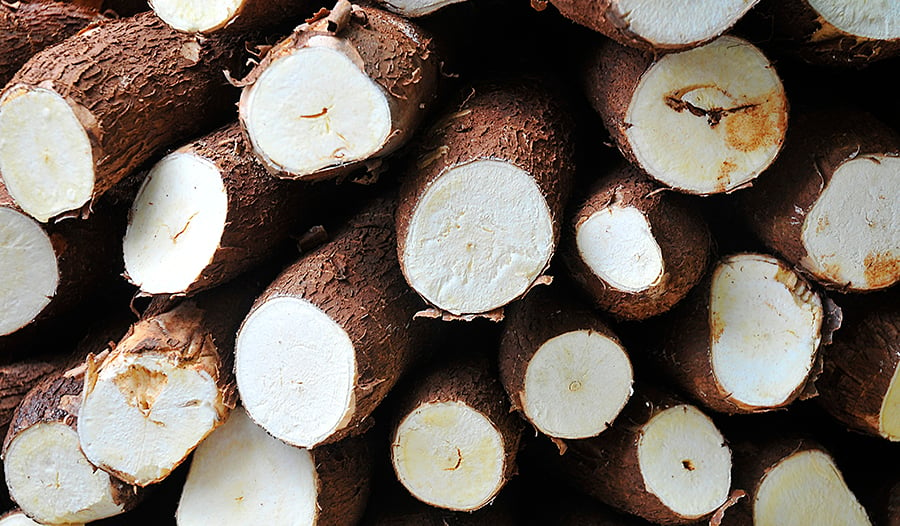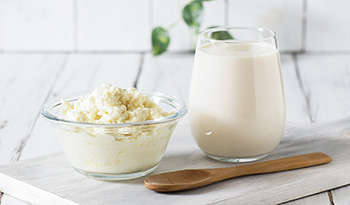Tapioca Fiber: Boost Fiber Intake + More

What Is Tapioca Fiber?
In the United States, most adults consume only about 15 grams of fiber per day. That is far below the recommended intake of 25-30 grams per day.
One of the emerging solutions to boosting fiber intake is tapioca fiber (Resistant Dextrin), also known as tapioca-resistant dextrin or cassava root fiber, which is emerging as one of the most beneficial and popular dietary fibers.
Resistant dextrin is produced through processing tapioca by heating in a low pH (mildly acidic) condition known as pyrodextrinization. This process transforms tapioca starch into a diverse mix of glucose chains that are resistant to digestion by human digestive enzymes.
What Does Tapioca Fiber Do In The Body?
As a soluble, fermentable fiber, it supports gut health while maintaining excellent process stability in a wide range of food and beverage formats.
Since the term “dietary fiber” primarily refers to indigestible carbohydrate structures and since tapioca fiber’s resistant dextrin is an indigestible starch, it meets the criteria for this classification. Resistant dextrin can also be made from wheat or corn, but tapioca resistant dextrin has some built-in advantages over these other sources.1
These indigestible bonds contribute to tapioca-resistant dextrin's prebiotic activity, low glycemic impact, and functional benefits in “better-for-you” food applications.
Health Benefits Of Tapioca Fiber
The health benefits of Tapioca fiber (Resistant Dextrin) can be divided into three main areas: gut health, metabolic support, and weight management.
Gut Health
The gut health-promoting effects of Tapioca fiber (Resistant Dextrin are related to the fact that it promotes proper elimination and bowel regularity as well as being a “prebiotic” that promotes the growth of beneficial gut bacteria. Resistant dextrin is also “selectively fermented” by gut bacteria to produce short-chain fatty acids (SCFAs)—particularly butyrate, a SCFA that is used by intestinal cells as an energy source and helps promote a proper intestinal environment and immune regulation.4
As a prebiotic, resistant dextrin shows some advantages over other prebiotics like chicory fiber (inulin), fructooligosaccharides (FOS), and acacia fiber. The primary advantage of resistant dextrin is that it ferments more slowly than these other prebiotic fibers, allowing it to feed bacteria where it is most important, the end of the small intestine and in the colon.
By fermenting more slowly and in a different location than the other prebiotics, tapioca fiber is much better tolerated and, unlike inulin and FOS, rarely produces gas or bloating. While acacia fiber is very gentle and well-tolerated, it is less effective as a prebiotic compared to resistant dextrin.4
Metabolic Support + Weight Management
Of the popular prebiotic fibers, Tapioca fiber (Resistant Dextrin) from any source shows the strongest effects on metabolic health, including improvements in insulin sensitivity, blood glucose control, lipid metabolism (cholesterol and triglycerides), and markers of inflammation (e.g., C-reactive protein). These health benefits have been demonstrated in several double-blind, placebo-controlled human studies at dosages ranging from 10 to 40 grams per day.3
Some of the benefits to metabolic health are thought to be due to resistant dextrin binding endotoxins, which are toxic components found in the outer membrane of a class of bacteria known as gram-negative rods. At low levels, such as those typically encountered in the gut, endotoxins are not harmful to health. But if endotoxin levels become elevated in the gut, they can lead to excessive gut permeability (i.e., a leaky gut). And if endotoxin levels rise in the bloodstream, it can trigger widespread inflammation, leading to poor liver function, blood sugar control, and lipid metabolism. Resistant dextrin improves the composition of the microbiome, leading to fewer endotoxin-producing bacteria, and it also can bind endotoxins to prevent their damaging effects and absorption.5-8
One double-blind study showed that when obese women with type 2 diabetes took 10 grams of resistant dextrin for a period of 8 weeks, they showed a significant decrease in blood endotoxin levels as well as improvements in blood sugar control, cortisol levels, and inflammatory mediators.
Interestingly, significant improvements were also noted in sleep quality and quality of life (QOL) measurements.8 Another study showed a significant cortisol-lowering effect (approximately a 20% decrease) in a similar female population.5
To maximize the benefits on metabolic health, Tapioca fiber (Resistant Dextrin) should be taken before or with meals. Doing so reduces after-meal spikes in blood sugar and insulin levels as well as promotes feelings of satiety in supporting reduced calorie intake while on weight management programs. Several double-blind studies in humans have shown that resistant dextrin produces significant benefits in supporting improved metabolic health and weight management.3,9-11
In women with polycystic ovary syndrome (PCOS), resistant dextrin consumption improved both metabolic and hormonal health status, including helping to reduce menstrual cycle irregularity.12
Dosage
For bowel regularity and general digestive support, a dosage of 7.5-10 grams per day is recommended. For metabolic and endotoxin-binding effects, the recommended dosage is 7.5-10 grams before meals two to three times daily. Unlike other prebiotics, tapioca fiber is well-tolerated in healthy adults even at single dosages up to 50 grams.
Gas and bloating are rarely experienced. If a person does experience these mild gastrointestinal effects, reduce the dosage to 5 grams once a day and gradually increase to the full dosage recommendation over 2 weeks to improve tolerance. Tapioca fiber can be mixed into beverages, smoothies, or soft foods, as it is soluble, neutral in taste, and stable to heat and pH.
Side Effects
Tapioca resistant dextrin shows some other advantages in that it has greater solubility, better tolerability (fewer side effects), and better actions supporting blood sugar control than other sources of resistant dextrin.
More specifically, resistant dextrin is slow to break down and does not cause bloating and gas even at dosages as high as 50 grams, making it highly tolerable yet fully utilized to maximize benefits.
Takeaway
Tapioca fiber is increasing in popularity as a dietary supplement as well as a source of soluble dietary fiber. It is fully soluble in water, has a neutral, slightly sweet taste, is low in calories, and has a near-zero glycemic index, so it does not raise blood sugar levels.1-3
References:
- Trithavisup K, Shi YC, Krusong K, Tananuwong K. Molecular structure and properties of cassava-based resistant maltodextrins. Food Chem. 2022 Feb 1;369:130876.
- Teo, Shaun Y M, Fairchild, Timothy J. Evaluation of the Gastrointestinal Tolerability of Fibersmart®, a Novel Dietary Fiber, Using a Randomized Controlled Trial in Healthy Men and Women. EC Nutrition 2021 October 16.12
- Hobden MR, Guérin-Deremaux L, Rowland I, et al. Potential anti-obesogenic properties of non-digestible carbohydrates: specific focus on resistant dextrin. Proc Nutr Soc. 2015 Aug;74(3):258-67.
- Włodarczyk M, Śliżewska K. Efficiency of Resistant Starch and Dextrins as Prebiotics: A Review of the Existing Evidence and Clinical Trials. Nutrients. 2021 Oct 26;13(11):3808.
- Farhangi MA, Javid AZ, Sarmadi B, Karimi P, Dehghan P. A randomized controlled trial on the efficacy of resistant dextrin, as functional food, in women with type 2 diabetes: Targeting the hypothalamic-pituitary-adrenal axis and immune system. Clin Nutr. 2018 Aug;37(4):1216-1223.
- Aliasgharzadeh A, Dehghan P, Gargari BP, Asghari-Jafarabadi M. Resistant dextrin, as a prebiotic, improves insulin resistance and inflammation in women with type 2 diabetes: a randomised controlled clinical trial. Br J Nutr. 2015 Jan 28;113(2):321-30.
- Farhangi MA, Dehghan P, Namazi N. Prebiotic supplementation modulates advanced glycation end-products (AGEs), soluble receptor for AGEs (sRAGE), and cardiometabolic risk factors through improving metabolic endotoxemia: a randomized-controlled clinical trial. Eur J Nutr. 2020 Oct;59(7):3009-3021.
- Saleh-Ghadimi S, Dehghan P, Sarmadi B, Maleki P. Improvement of sleep by resistant dextrin prebiotic in type 2 diabetic women coincides with attenuation of metabolic endotoxemia: involvement of gut-brain axis. J Sci Food Agric. 2022 Sep;102(12):5229-5237.
- Ang J, See E, Perreau C, Thabuis C, Guérin-Deremaux L, Henry CJ, Bi X. NUTRIOSE® soluble fibre supplementation as an effective dietary strategy to improve glycaemic response. Eur J Nutr. 2025 Apr 1;64(3):143.
- Hobden MR, Commane DM, Guérin-Deremaux L, et al. Impact of dietary supplementation with resistant dextrin (NUTRIOSE®) on satiety, glycaemia, and related endpoints, in healthy adults. Eur J Nutr. 2021 Dec;60(8):4635-4643.
- Kanahori S, Hatakeyama Y, Tomita S, Fukuhara I. Visceral Fat-Reducing Effect and Safety of Continuous Consumption of Beverage Containing Resistant Maltodextrin: A Randomized, Double-Blind, Placebo-Controlled, Parallel-Group Clinical Trial. J Nutr Sci Vitaminol (Tokyo). 2020;66(5):417-426.
- Gholizadeh Shamasbi S, Dehgan P, Mohammad-Alizadeh Charandabi S, et al. The effect of resistant dextrin as a prebiotic on metabolic parameters and androgen level in women with polycystic ovarian syndrome: a randomized, triple-blind, controlled, clinical trial. Eur J Nutr. 2019 Mar;58(2):629-640.
DISCLAIMER:This Wellness Hub does not intend to provide diagnosis...

















































































 Table of Contents
Table of Contents














